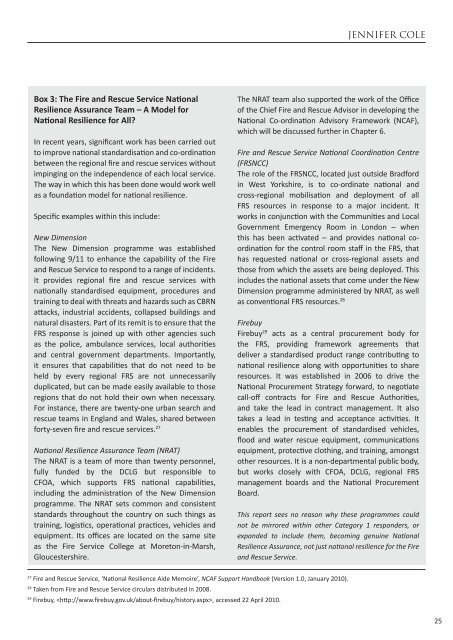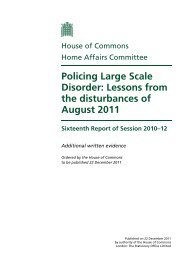INTEROPERABILITY IN A CRISIS 2 - RUSI
INTEROPERABILITY IN A CRISIS 2 - RUSI
INTEROPERABILITY IN A CRISIS 2 - RUSI
Create successful ePaper yourself
Turn your PDF publications into a flip-book with our unique Google optimized e-Paper software.
Box 3: The Fire and Rescue Service National<br />
Resilience Assurance Team – A Model for<br />
National Resilience for All?<br />
In recent years, significant work has been carried out<br />
to improve national standardisation and co-ordination<br />
between the regional fire and rescue services without<br />
impinging on the independence of each local service.<br />
The way in which this has been done would work well<br />
as a foundation model for national resilience.<br />
Specific examples within this include:<br />
New Dimension<br />
The New Dimension programme was established<br />
following 9/11 to enhance the capability of the Fire<br />
and Rescue Service to respond to a range of incidents.<br />
It provides regional fire and rescue services with<br />
nationally standardised equipment, procedures and<br />
training to deal with threats and hazards such as CBRN<br />
attacks, industrial accidents, collapsed buildings and<br />
natural disasters. Part of its remit is to ensure that the<br />
FRS response is joined up with other agencies such<br />
as the police, ambulance services, local authorities<br />
and central government departments. Importantly,<br />
it ensures that capabilities that do not need to be<br />
held by every regional FRS are not unnecessarily<br />
duplicated, but can be made easily available to those<br />
regions that do not hold their own when necessary.<br />
For instance, there are twenty-one urban search and<br />
rescue teams in England and Wales, shared between<br />
forty-seven fire and rescue services. 27<br />
National Resilience Assurance Team (NRAT)<br />
The NRAT is a team of more than twenty personnel,<br />
fully funded by the DCLG but responsible to<br />
CFOA, which supports FRS national capabilities,<br />
including the administration of the New Dimension<br />
programme. The NRAT sets common and consistent<br />
standards throughout the country on such things as<br />
training, logistics, operational practices, vehicles and<br />
equipment. Its offices are located on the same site<br />
as the Fire Service College at Moreton-in-Marsh,<br />
Gloucestershire.<br />
jENNIFER COLE<br />
The NRAT team also supported the work of the Office<br />
of the Chief Fire and Rescue Advisor in developing the<br />
National Co-ordination Advisory Framework (NCAF),<br />
which will be discussed further in Chapter 6.<br />
Fire and Rescue Service National Coordination Centre<br />
(FRSNCC)<br />
The role of the FRSNCC, located just outside Bradford<br />
in West Yorkshire, is to co-ordinate national and<br />
cross-regional mobilisation and deployment of all<br />
FRS resources in response to a major incident. It<br />
works in conjunction with the Communities and Local<br />
Government Emergency Room in London – when<br />
this has been activated – and provides national coordination<br />
for the control room staff in the FRS, that<br />
has requested national or cross-regional assets and<br />
those from which the assets are being deployed. This<br />
includes the national assets that come under the New<br />
Dimension programme administered by NRAT, as well<br />
as conventional FRS resources. 28<br />
Firebuy<br />
Firebuy 29 acts as a central procurement body for<br />
the FRS, providing framework agreements that<br />
deliver a standardised product range contributing to<br />
national resilience along with opportunities to share<br />
resources. It was established in 2006 to drive the<br />
National Procurement Strategy forward, to negotiate<br />
call-off contracts for Fire and Rescue Authorities,<br />
and take the lead in contract management. It also<br />
takes a lead in testing and acceptance activities. It<br />
enables the procurement of standardised vehicles,<br />
flood and water rescue equipment, communications<br />
equipment, protective clothing, and training, amongst<br />
other resources. It is a non-departmental public body,<br />
but works closely with CFOA, DCLG, regional FRS<br />
management boards and the National Procurement<br />
Board.<br />
This report sees no reason why these programmes could<br />
not be mirrored within other Category 1 responders, or<br />
expanded to include them, becoming genuine National<br />
Resilience Assurance, not just national resilience for the Fire<br />
and Rescue Service.<br />
27 Fire and Rescue Service, ‘National Resilience Aide Memoire’, NCAF Support Handbook (Version 1.0, January 2010).<br />
28 Taken from Fire and Rescue Service circulars distributed in 2008.<br />
29 Firebuy, , accessed 22 April 2010.<br />
25

















